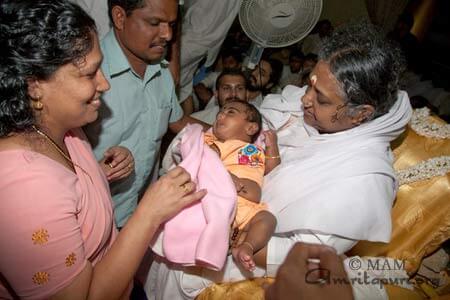Category: Disaster Relief
-
Andra Flood Relief Work Photos
Photos of the flood relief work undertaken by Mata Amritanandamayi Math in Kurnool district of Andra Pradesh
-
Bengal Cyclone Aila Relief
Cyclone Aila hit West Bengal and Bangladesh on 25 May 2009. By the time it dissipated a day later, 330 people were dead, more than 8,000 were missing and one million were homeless. Between Indian and Bangladesh, damages exceeded $40 million US.
-
Bihar Flood Relief Work of MAM
On August 18, 2008, the Kosi River broke through a man-made embankment in Nepal. The flooding was massive and engulfed half the neighboring state of Bihar in India.
-

Sixth Tsunami Baby Arrives
24 December 2008 — Amritapuri After the Indian Ocean Tsunami of 2004, several women from the villages surrounding Amritapuri came to Amma telling of a peculiar and tragic plight. Not only had they lost their children in the disaster, they were also unable to have more, as they had long back opted to undergo tubal…
-
The Life After: Bihar floods
After three months and more the government has started on the second phase of the rehabilitation project – taking census of losses suffered by individual farmers, so that compensation can be granted under different heads. The waters have receded in most places, a majority of the people have returned to their villages, and are now…
-
Bihar Flood: Medical Service
Medicine In response to the Bihar flood, AIMS Hospital dispatched teams of specialists and paramedics who treated more than 400 patients daily, sometimes seeing to more than 500. Not only did the doctors treat wounds, respiratory problems like pneumonia and fungal growths, they also delivered several babies. Ambulances and a Mobile Telemedicine Unit were also…
-
Bihar Flood: Distribution of Food & Clothes
MAM provided food and clothing to thousands of flood victims, including blankets, clothes and other essentials for the victims of the flood in Bihar.
-
Bihar Floods: Telemedicine
Telemedicne Two state–of-the art ambulances were sent to the area via rail from Kochi, a total of distance of almost 2,500 km. One of these was AIMS Hospital’s Mobile Telemedicine Unit. It is the size of a city bus and includes X-ray facilities, ECG scanner, pathology-lab-work facility, specialty cardiac services and a telemedicine satellite link…
-
Bihar flood: Educational Support
Educational Support In MAM’s relief camps, temporary classes were arranged—for children aged three to six, and a separate section for those aged seven to 15. School supplies like notebooks, pencils, etc were distributed to the children.
-
Bihar Flood Relief Camps
Camps: Construction and Life MAM set up two relief camps. One in Purnia District, and one in Supaul District. The first was completed on 16th September; the second on 11th October. In total, 1,500 flood victims were housed in the shelters. Kitchens and toilets were also provided. At one point, when construction supplies were delayed,…
